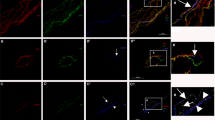Abstract
In a previous pilot study we suggested the novel notion that the catecholaminergic sympathetic nerve endings are non-homogeneously distributed in the rat skin. In the present study we have utilized several independent methods to determine the in vivo distribution of catecholamine-containing fibers in rat skin. Using whole body macro-autoradiography with an iodine125-labeled tyrosine, we localized the distribution of iodine-125-catecholamine in rat skin. The images on the film showed various pairs of symmetrical linear arrays running from the head through the back and to the hind limbs of the animal that we arbitrarily termed sympathetic substance lines (SSLs). The distribution of catecholamine in rat skin was also visualized by light microscopy autoradiography with tritiated tyrosine. The majority of silver grains in the sections were located among hair follicles along a band or zone. Furthermore, a modified sucrose-phosphate-glyoxilic acid (SPG) method was adapted to observe sympathetic fibers in the skin sections. Dense clusters of fluorescent nerve fibers in correspondence of arrector pili muscles (AP muscles) were located along lengthwise lines of the body, in a pattern coinciding with the linear arrays identified by macro-autoradiography. We concluded that concentrated clusters of noradrenergic nerve fibers innervate AP muscles and form a longitudinal linear system in the whole skin. These results are discussed in terms of physiological functions associated with hair follicles, sensory signal pathways and Meridians in Chinese traditional medicine.










Similar content being viewed by others
References
Akoev GN (1981) Catecholamines, acetylcholine and excitability of mechanoreceptors. Neurobiology 15:269–294
Burch GE, Phillips JH (1958) Chromaffin reacting cells in human digital skin. Circ Res 6:416–423
Calof AL, Jones RB, Roberts WJ (1981) Sympathetic modulation of mechanoreceptor sensitivity in frog skin. J Physiol 310:481–499
Cheng SB, Ding LK (1973) Practical application of acupuncture analgesia. Nature 242:559–560
Chung SH, Dickenson A (1980) Pain, enkephalin and acupuncture. Nature 283: 243–244
Clark WC, Yang JC (1974) Acupunctural analgesia? Evaluation by signal detection theory. Science 184:1096–1098
DeLa Torre JC (1980) An improved approach to histofluorescence using the SPG method for tissue monoamines. J Neurosci Methods 3:1–5
Drummond PD, Lipnicki DM (1999) Noradrenaline provokes axon reflex hyperaemia in the skin of the human forearm. J Auton Nerv Syst 77:39–44
Gottschaldt KM, Vahle-Hinz C (1981) Merkel cell receptors: structure and transducer function. Science 214:183–186
Halata Z (1993) Sensory innervation of the hairy skin (light- and electron microscopic study. J Invest Dermatol 101(Suppl 1):75–81
Kissin I, McDonald J, Brown PT, Xavier AV, Bradley EL Jr (1987) Sympathetic blockade increases tactile sensitivity. Anesth Analg 66:1251–1255
Kozyreva TV, Tkachenko EY, Kozaruk VP, Latysheva TV, Gilinsky MA (1999) Effects of slow and rapid cooling on catecholamine concentration in arterial plasma and the skin. Am J Physiol 276:1668–1672
Liu LY, Peng A, Pan J, Zhuang H (2001) Sensitive lines of sympathetic nerve and essence of Meridians. Chin Acupunct & Moxibustion 21:285–289
Loewenstein WR (1956) Modulation of cutaneous mechanoreceptors by sympathetic stimulation. J Physiol 132:40–60
Ma SX, Ma J, Moise G, Li XY (2005) Responses of neuronal nitric oxide synthase expression in the brainstem to electroacupuncture Zusanli (ST 36) in rats. Brain Res 1037:70–77
Narisawa Y, Hashimoto K, Kohda H (1994) Merkel cells of the terminal hair follicle of the adult human scalp. J Invest Dermatol 102:506–514
Roberts WJ, Levitt G (1982) Histochemical evidence for sympathetic innervation of hair sympathetic innervation of hair receptor afferents in cat skin. J Comp Neurol 210:204–209
Roth S, Kummer W (1994) A quantitative ultrastructural investigation of tyrosine hydroxylase-immunoreactive axons in the hairy skin of the guinea pig. Anat Embryol 190:155–162
Shortland P, Woolf CJ, Fitzgerald M (1989) Morphology and somatotopic organization of the central terminals of hind limb hair follicle afferents in the rat lumbar spinal cord. J Comp Neurol 289:416–433
Taub A (1972) Acupuncture. Science 178:9
Waris T, Rechardt L (1977) Histochemically demonstrable catecholamines and cholinesterases in nerve fibres of rat dorsal skin. Histochemistry 53: 203–206
Xie Y, Li H, Xiao W (1996) Neurobiological mechanisms of the meridian and the propagation of needle feeling along the meridian pathway. Sci China C Life Sci 39:99–112
Acknowledgements
This project was supported by NSFC.
Author information
Authors and Affiliations
Corresponding author
Rights and permissions
About this article
Cite this article
Liu, LY., Zhang, H., Pan, J. et al. The existence of a linear system consisting of sympathetic endings in rat skin. Anat Embryol 210, 91–100 (2005). https://doi.org/10.1007/s00429-005-0007-7
Accepted:
Published:
Issue Date:
DOI: https://doi.org/10.1007/s00429-005-0007-7




